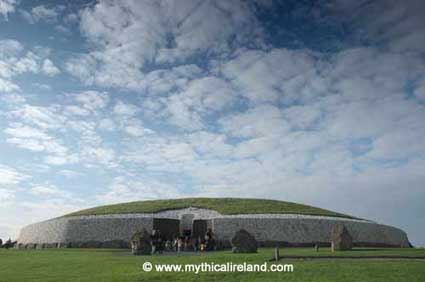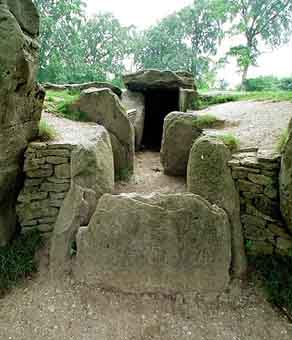![]()
![]()
x. Swan Knights and Swan Maidens

The gigantic passage grave encircled by a massive stone circle to be
seen at Newgrange in Ireland's Boyne Valley is famous for its alignment
towards the midwinter solstice. Each year the first sunlight penetrates
a narrow corridor and enters a womb-like chamber at the heart of the
monument, built c. 3000 BC. In it's an enchanting spectacle that befits
its former identity as a sidhe, a house or palace, of the Tuatha de
Danaan, the mythical first inhabitants of Ireland. In this guise it
features in the old Irish tale known as 'The Dream of Angus', concerning
a chieftain named Angus Mac Og, whose story relates how he fell in love
with a swan-maiden after she visited him in a dream. After she agreed
to marry him, they fly off to Newgrange in the form of swans, where
they lived happily ever after. In Scottish folklore, Angus was married
to the goddess Bride, who was herself a swan-maiden.
All this was knowledge known to two Irish earth mysteries researchers, Anthony Murphy and Richard Moore, who linked it with the fact that each winter flocks of migrating swans settle for the winter in the water-logged meadows of the Boyne Valley. Sensing that this annual spectacle might have influenced the mythology and practices of those who built the Newgrange monument, they wondered whether the passage grave reflected the influence not just of the sun, but also that of Cygnus, the celestial swan.
|
Newgrange passage grave. Picture credit: Anthony Murphy/Mythicalireland.com |
Overlaying the stars on a map of Newgrange, they determined that the monument's interior echoes the arrangement of Cygnus's principal stars (see their site mythicalireland.com). Moreover, if the midwinter sunrise line is extended backwards some 15 kilometres (9 miles), it targets a smaller passage grave known as Fourknocks. This they found to be aligned perfectly to the rising of Deneb in c. 3000 BC. Thus the solsticial sun has to pass through a Deneb aligned site before reaching Newgrange, which is itself a terrestrial form of the swan, reflected in 'The Dream of Angus'. |
Similar tales of shape-shifting swan-maidens can be found across Northern and Central Europe. In these one of their number is usually caught and made to marry a mortal man, after he steals her cloak of feathers as she bathes with other swan-maidens. Such stories are linked also with the European tradition of 'Le Chevalier du Cygne ('Knight of the Swan'), descended of a swan-maiden M, creating the archaic belief that certain families and individuals were descended from a mythical swan-knight. These includes the Cleves family, from whom came Annes of Cleves, wife and queen of the English king Henry VIII, and Godfrei de Bouillon, the leader of the First Crusade.
Traditions of this sort hark back to an age when magical flight was thought to be attained by the male or female shaman through wearing either a cloak of swan feathers or other swan paraphernalia, evidence of which occurs in these same countries, and also in many parts of Asia and the Indian sub-continent, where swan veneration was prominent in the past. Moreover, in Denmark archaeologists have discovered a unique burial in a cemetery dating to the Mesolithic age, c. 4800 BC. A young woman was found beneath a small knoll, next to her dead child, who had been laid to rest on a swan's wing. Its striking presence has been seen by some archaeologists as evidence of a link between the swan and the transmigration of the soul. If correct it shows the antiquity of this cult, which preceded even the spread of Europe's megalithic culture, of which both Avebury and Newgrange are prime examples.
| Yet the connection between swan-maidens and prehistoric tombs is not confined to Newgrange, for at the Wayland Smithy long barrow situated some 40 kilometres (25 miles) from Avebury, a legend connects the founder Wayland, or Weland, the Germanic and Norse divine smith, with the cult of the swan. It was written that he escaped from the labours imposed on him by the wicked king Niðuð by wearing a swan coat, enabling him to achieve magical flight. In some versions of the tale, this was given to him by his wife, who was a Valkyrie. They were female spirits, shape-shifting swan-maidens, who carried the souls of the dead to Valhalla, the Hall of the Heroes in Norse myth. Although Wayland's link with the monument that bears his name post-dates its construction by some 4,000 years, it cannot be coincidence that, quite separately, prehistorian Professor John North determined that Wayland Smithy is aligned to Deneb, suggesting that a swan cult existed here as early as c. 3700 BC, its accepted date of construction. |
Wayland Smithy long barrow. |
From Wayland Smithy we travel to the Scottish Outer Hebrides, where at Callanish on the Isle of Lewis, we find one of the most impressive stone circles in Britain. Legends speak of it being built by a black-skinned people who arrived in the company of a white priest-king dressed in a coat of mallard feathers, which along with swan feathers was the traditional garment of a Gaelic bard.
Callanish's northern avenue of stones points towards a distant hill in the NNE, and it can be shown that this alignment targets the point in the sky where in 3000 BC Sadr (gamma Cygni), the star at the centre of Cygnus's cross-like design, would climb high enough to return to life after having faded out as it crossed the meridian from left to right. This would have been a magical sight to anyone present, and so makes sense of why the stone avenue was built to mark this remarkable phenomenon. Aubrey Burl argues that Callanish's foundation story associates it with a rebirth cult linked with water and waterfowl. It is a conclusion that adds weight to Callanish's proposed Cygnus alignment, which must now be seen as part of a more widespread religion that embraced the megalithic world with its own unique religious practices associated with cosmic life and death. Yet having established the reality of the cult in megalithic Britain, we now go in search of the Cygnus mystery to Egypt, where we come a little closer to understanding the constellation's greater purpose in the minds of our most distant ancestors.
![]()
![]()

